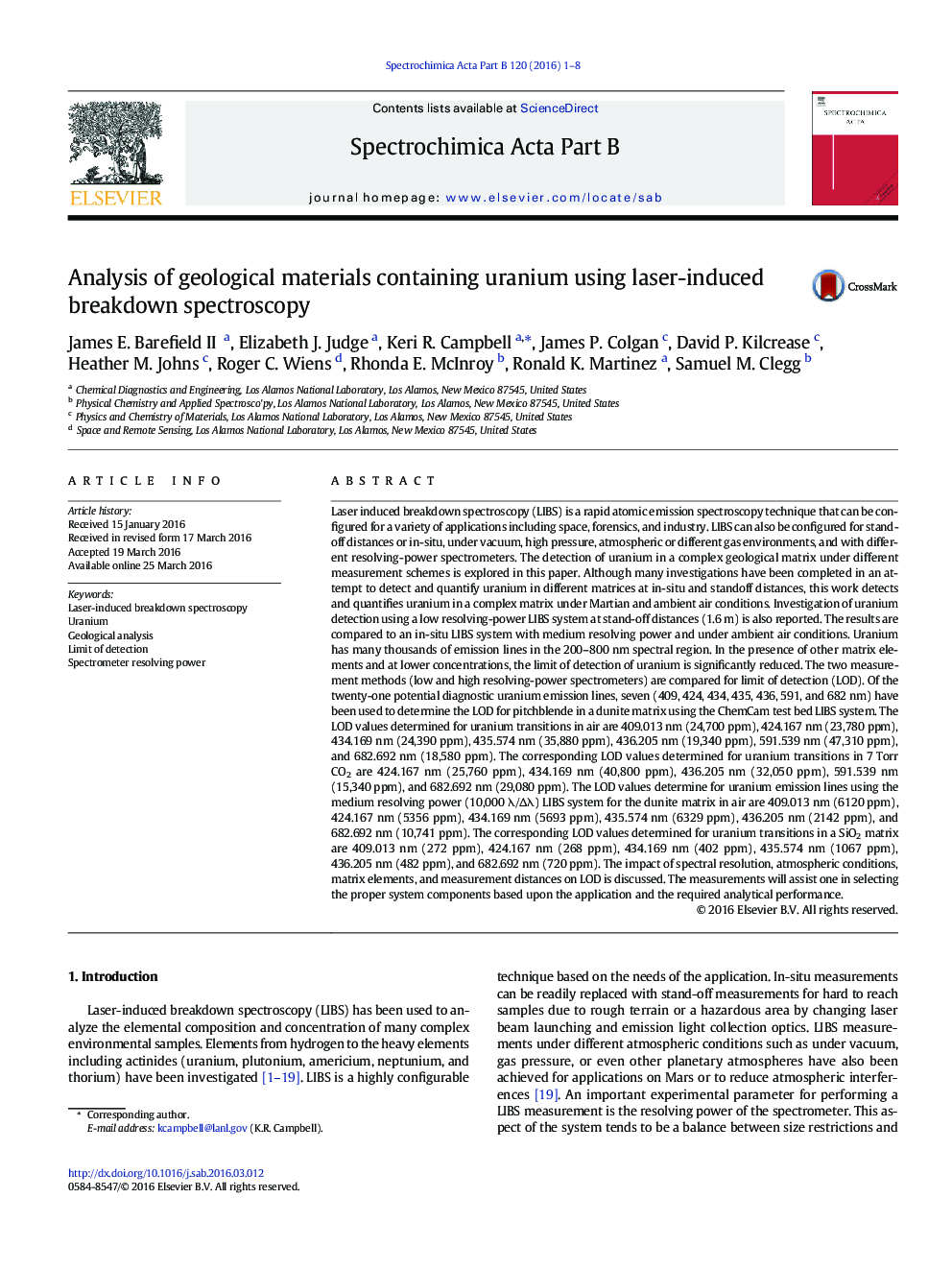| کد مقاله | کد نشریه | سال انتشار | مقاله انگلیسی | نسخه تمام متن |
|---|---|---|---|---|
| 1239655 | 1495683 | 2016 | 8 صفحه PDF | دانلود رایگان |
• Impact of spectral resolution, atmosphere, matrix, and measurement distances on LOD presented.
• The measurements will assist selecting the proper system components based on the application.
• Range of LOD for ChemCam test bed for U in dunite is 18,580–47,310 ppm in air and 15,340–40,800 ppm in CO2.
• Range of LOD for medium resolving power LIBS of U in dunite is 2142–10,741 ppm and 268–1067 ppm in SiO2.
Laser induced breakdown spectroscopy (LIBS) is a rapid atomic emission spectroscopy technique that can be configured for a variety of applications including space, forensics, and industry. LIBS can also be configured for stand-off distances or in-situ, under vacuum, high pressure, atmospheric or different gas environments, and with different resolving-power spectrometers. The detection of uranium in a complex geological matrix under different measurement schemes is explored in this paper. Although many investigations have been completed in an attempt to detect and quantify uranium in different matrices at in-situ and standoff distances, this work detects and quantifies uranium in a complex matrix under Martian and ambient air conditions. Investigation of uranium detection using a low resolving-power LIBS system at stand-off distances (1.6 m) is also reported. The results are compared to an in-situ LIBS system with medium resolving power and under ambient air conditions. Uranium has many thousands of emission lines in the 200–800 nm spectral region. In the presence of other matrix elements and at lower concentrations, the limit of detection of uranium is significantly reduced. The two measurement methods (low and high resolving-power spectrometers) are compared for limit of detection (LOD). Of the twenty-one potential diagnostic uranium emission lines, seven (409, 424, 434, 435, 436, 591, and 682 nm) have been used to determine the LOD for pitchblende in a dunite matrix using the ChemCam test bed LIBS system. The LOD values determined for uranium transitions in air are 409.013 nm (24,700 ppm), 424.167 nm (23,780 ppm), 434.169 nm (24,390 ppm), 435.574 nm (35,880 ppm), 436.205 nm (19,340 ppm), 591.539 nm (47,310 ppm), and 682.692 nm (18,580 ppm). The corresponding LOD values determined for uranium transitions in 7 Torr CO2 are 424.167 nm (25,760 ppm), 434.169 nm (40,800 ppm), 436.205 nm (32,050 ppm), 591.539 nm (15,340 ppm), and 682.692 nm (29,080 ppm). The LOD values determine for uranium emission lines using the medium resolving power (10,000 λ/Δλ) LIBS system for the dunite matrix in air are 409.013 nm (6120 ppm), 424.167 nm (5356 ppm), 434.169 nm (5693 ppm), 435.574 nm (6329 ppm), 436.205 nm (2142 ppm), and 682.692 nm (10,741 ppm). The corresponding LOD values determined for uranium transitions in a SiO2 matrix are 409.013 nm (272 ppm), 424.167 nm (268 ppm), 434.169 nm (402 ppm), 435.574 nm (1067 ppm), 436.205 nm (482 ppm), and 682.692 nm (720 ppm). The impact of spectral resolution, atmospheric conditions, matrix elements, and measurement distances on LOD is discussed. The measurements will assist one in selecting the proper system components based upon the application and the required analytical performance.
Journal: Spectrochimica Acta Part B: Atomic Spectroscopy - Volume 120, 1 June 2016, Pages 1–8
